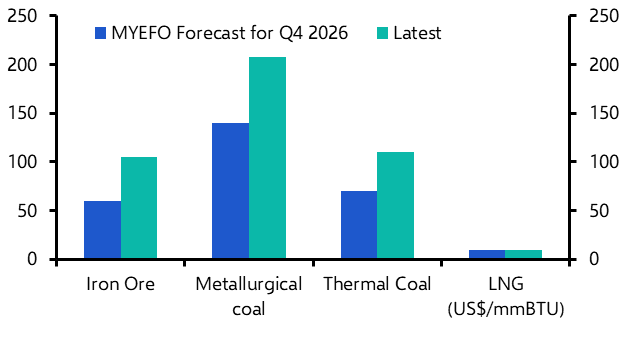For those worried about the prospects of an imminent US recession the past couple of weeks have brought some better news: while the latest economic data have generally remained soft, there have at least been signs of improvement in some sectors. Manufacturing output grew in August, retail sales for the same month were robust, housing activity is rebounding and the PMIs edged up a bit in September. Admittedly, data released on Friday showed that personal spending and durable goods orders were weak in August, meaning we’ve nudged down our forecast for Q3 GDP growth. But the bigger picture is that the economy is slowing rather than collapsing. According to our proprietary indicator, the chances of a US recession over the next year has dropped back over the past week or so.
However, while the data from the US have improved a little, the data from the euro-zone have gone from bad to worse. The flash manufacturing and services Composite PMI for the euro-zone (released last week) fell again in September and is now running at a six-year low. And while the headline Ifo Business Climate Index for Germany (also released last week) ticked up, the expectations index, which has a better relationship with GDP growth, fell once again. It remains consistent with another contraction in the economy in Q3, which, if confirmed, would leave Germany in recession.
Our 2020 GDP forecasts for the euro-zone were already towards the very bottom of the consensus range, but we’ve cut them further over the past week. You can read the detail here but the short point is that we now expect the euro-zone to grow by just 0.5% next year. While France and Spain will remain relative bright spots, we think Germany’s economy will stay in or close to recession until mid-2020 and that Italy’s will flat-line throughout our forecast horizon.
If we’re right, then this is ultimately likely to prompt further policy easy by the ECB – despite mounting opposition from some on the Governing Council. We now expect further cuts in the benchmark deposit rate (to -0.8% by end-2020) and an increase the pace of asset purchases (to €30bn per month). (Again, see here for more details.)
If that’s not bad enough, the recent signs from China have not been encouraging either. So far, at least, China’s economy has remained resilient in the face of domestic headwinds and the escalating trade war with the US. Our proprietary China Activity Proxy suggests that growth has been broadly stable over the past few months and may even have accelerated a little in the first half of this year. Yet the resilience of the headline growth numbers masks a divergence in the performance of individual sectors. Several parts of China’s economy – particularly those connected to manufacturing and industry – have been extremely weak. But aggregate growth has been propped up by the strength of property construction.
We’ve argued for a while that the rapid growth of property construction was unsustainable and there are now signs in the latest data that it may have peaked. (See here for more.) If the property sector starts to slow over the coming months, as we suspect, then a key prop to the economy over the past year will be removed and overall growth is likely to edge down. This will have several consequences. One is that the People’s Bank – much like the ECB – will have more work to do. Another is that – despite some better news from the US – global GDP growth is likely to slow further over the final months of this year. The world economy, it seems, can’t catch a break at the moment.
In case you missed it:
- Our Senior Japan Economist, Marcel Thielant, looks at what will guide the BoJ’s forthcoming “re-examination” of policy.
- Our Asset Allocation team argues that a fall in equity markets wouldn’t necessarily lead to a rally in bond markets.
- Our Senior Europe Economist, David Oxley, gets into the weeds of Norway’s interest rate markets.



